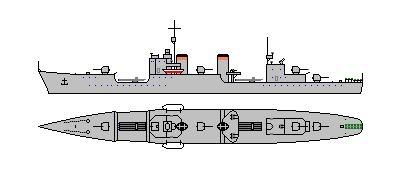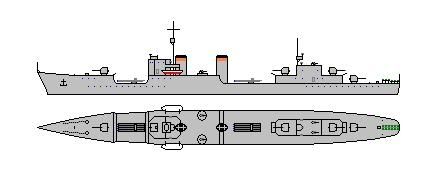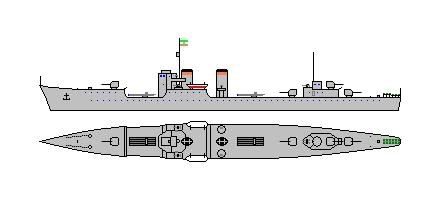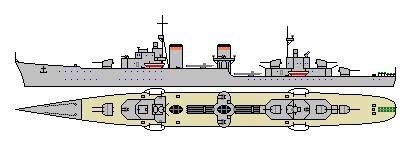Rawalpindi Class
New generation destroyers built to escort carriers. Reduced deck space results in just one bank of torpedoes, though a set of reloads is embarked.
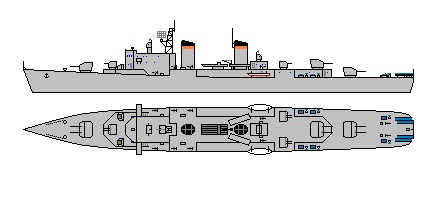
Rawalpindi, D-91, laid down 1944
Faisalabad, D-92, laid down 1944
Sargodha, D-93, laid down 1944
Madurai, D-94, laid down 1944
Coimbatore, D-95, laid down 1944
Nashik, D-96, laid down 1944
Enter ship name, Enter country Enter ship type laid down 1944
Displacement:
2,091 t light; 2,222 t standard; 2,546 t normal; 2,805 t full load
Dimensions: Length overall / water x beam x draught
390.74 ft / 379.10 ft x 42.65 ft x 13.12 ft (normal load)
119.10 m / 115.55 m x 13.00 m x 4.00 m
Armament:
6 - 4.92" / 125 mm guns (3x2 guns), 59.59lbs / 27.03kg shells, 1944 Model
Dual purpose guns in deck mounts with hoists
on centreline ends, majority aft, 1 raised mount aft - superfiring
4 - 2.24" / 57.0 mm guns (2x2 guns), 5.65lbs / 2.56kg shells, 1944 Model
Dual purpose guns in deck mounts
on side, all amidships, all raised mounts - superfiring
2 - 2.24" / 57.0 mm guns (1x2 guns), 5.65lbs / 2.56kg shells, 1944 Model
Dual purpose guns in deck mount
on centreline forward, all raised guns - superfiring
10 - 0.98" / 25.0 mm guns in single mounts, 0.48lbs / 0.22kg shells, 1944 Model
Machine guns in deck mounts
on side, evenly spread, all raised mounts
Weight of broadside 396 lbs / 180 kg
Shells per gun, main battery: 350
5 - 21.7" / 550 mm above water torpedoes
Armour:
- Gun armour: Face (max) Other gunhouse (avg) Barbette/hoist (max)
Main: 1.97" / 50 mm 0.79" / 20 mm 1.97" / 50 mm
3rd: 0.98" / 25 mm 0.39" / 10 mm -
4th: 0.98" / 25 mm 0.39" / 10 mm -
5th: 0.39" / 10 mm - -
Machinery:
Oil fired boilers, steam turbines,
Geared drive, 2 shafts, 48,258 shp / 36,000 Kw = 34.38 kts
Range 7,000nm at 15.00 kts
Bunker at max displacement = 583 tons
Complement:
178 - 232
Cost:
£1.837 million / $7.350 million
Distribution of weights at normal displacement:
Armament: 50 tons, 1.9 %
Armour: 30 tons, 1.2 %
- Belts: 0 tons, 0.0 %
- Torpedo bulkhead: 0 tons, 0.0 %
- Armament: 30 tons, 1.2 %
- Armour Deck: 0 tons, 0.0 %
- Conning Tower: 0 tons, 0.0 %
Machinery: 1,131 tons, 44.4 %
Hull, fittings & equipment: 739 tons, 29.0 %
Fuel, ammunition & stores: 456 tons, 17.9 %
Miscellaneous weights: 141 tons, 5.5 %
-50 t: Radar, sonar, fire control, and other electronics
-31 t: Weight reserve
-20 t: Rails, throwers, and 60 depth charges
-20 t: Mangus ASW system and five reload salvoes (abaft "B" gun)
-10 t: Blast shielding around Mangus and deck reinforcement below.
-10 t: Torpedo reloads and equipment
Overall survivability and seakeeping ability:
Survivability (Non-critical penetrating hits needed to sink ship):
812 lbs / 368 Kg = 13.6 x 4.9 " / 125 mm shells or 0.4 torpedoes
Stability (Unstable if below 1.00): 1.20
Metacentric height 2.0 ft / 0.6 m
Roll period: 12.8 seconds
Steadiness - As gun platform (Average = 50 %): 60 %
- Recoil effect (Restricted arc if above 1.00): 0.35
Seaboat quality (Average = 1.00): 0.87
Hull form characteristics:
Hull has a flush deck
and transom stern
Block coefficient: 0.420
Length to Beam Ratio: 8.89 : 1
'Natural speed' for length: 22.68 kts
Power going to wave formation at top speed: 69 %
Trim (Max stability = 0, Max steadiness = 100): 69
Bow angle (Positive = bow angles forward): 20.00 degrees
Stern overhang: 3.28 ft / 1.00 m
Freeboard (% = measuring location as a percentage of overall length):
- Stem: 22.97 ft / 7.00 m
- Forecastle (20 %): 19.03 ft / 5.80 m
- Mid (50 %): 15.09 ft / 4.60 m
- Quarterdeck (15 %): 15.09 ft / 4.60 m
- Stern: 15.09 ft / 4.60 m
- Average freeboard: 16.78 ft / 5.12 m
Ship space, strength and comments:
Space - Hull below water (magazines/engines, low = better): 166.4 %
- Above water (accommodation/working, high = better): 138.6 %
Waterplane Area: 10,465 Square feet or 972 Square metres
Displacement factor (Displacement / loading): 84 %
Structure weight / hull surface area: 41 lbs/sq ft or 198 Kg/sq metre
Hull strength (Relative):
- Cross-sectional: 0.50
- Longitudinal: 1.67
- Overall: 0.56
Hull space for machinery, storage, compartmentation is cramped
Room for accommodation and workspaces is excellent
Poor seaboat, wet and uncomfortable, reduced performance in heavy weather
